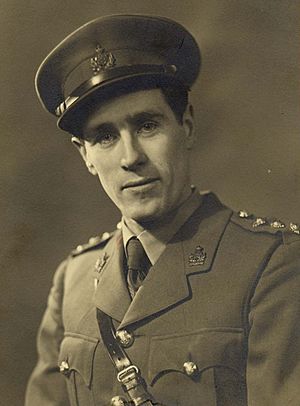Jerry Roberts facts for kids
Quick facts for kids
Jerry Roberts
MBE |
|
|---|---|

Capt. Jerry Roberts MBE photographed at Bletchley Park where he worked from 1941–45. He was a linguist and leading codebreaker on the Cryptanalysis of the Lorenz cipher.
|
|
| Born | 18 November 1920 |
| Died | 25 March 2014 (aged 93) |
| Nationality | British |
| Education | University College London 1939–1941 in German and French |
| Occupation | Business owner. Wartime codebreaker and linguist on the Lorenz cipher system |
Jerry Roberts was a brilliant British codebreaker and businessman. He was born on November 18, 1920, and passed away on March 25, 2014. During World War II, Jerry worked at a secret place called Bletchley Park in England. From 1941 to 1945, he helped break the most secret codes used by the Nazis. His work on the Lorenz cipher system was super important.
Jerry grew up in Wembley, London. His father worked for a bank, and his mother was a talented pianist. Jerry went to Latymer Upper School and then to University College London. He studied German and French, which became very useful later on.
Contents
Becoming a Codebreaker
Early in World War II, Jerry's university tutor knew about his language skills. He suggested Jerry for a secret job at Bletchley Park. This was a top-secret center where Britain tried to break enemy codes. Jerry was interviewed and accepted as a codebreaker and linguist.
Working on the Lorenz Cipher
Jerry Roberts became one of the first four members of a special team called the Testery at Bletchley Park. This team's big job was to break the Lorenz cipher code. The British called this code "Tunny." It was the Nazis' most secret communication system.
The Lorenz cipher was used for messages between the German Army High Command in Berlin and their armies across Europe. Some of these messages were even signed by Adolf Hitler himself! The Lorenz machine was much more complex than the well-known Enigma machine. It had 12 wheels, while Enigma had only 3.
The Testery's Important Work
Jerry worked in the Testery until the war ended. The team grew to include many codebreakers and support staff. They worked in three shifts, around the clock, to break the codes. Jerry was one of the shift leaders.
At first, they broke messages by hand. Later, a new section called the Newmanry developed machines to help. These machines, like the famous Colossus, sped up part of the code-breaking process. However, the Testery still did much of the work by hand.
The Testery was incredibly successful. From mid-1943 onwards, they broke over 90% of the Lorenz messages.
Impact of Codebreaking
Tens of thousands of Lorenz messages were intercepted and broken at Bletchley Park. These messages gave the British vital information about German plans. Breaking the "Tunny" code provided insights that changed the course of the war. It helped save many lives at key moments, like the Battle of Kursk and D-Day.
General Dwight D. Eisenhower, who later became a U.S. President, said that Bletchley Park's codebreaking "shortened the war by at least 2 years."
Life After the War
After World War II, Jerry Roberts joined the War Crimes Investigation Unit. He used his German and French language skills to interview witnesses and victims. He helped gather information for legal cases in the British Zone of Germany.
A New Career in Business
In 1948, Jerry started a new career in market research. This means he helped companies understand what people wanted to buy. He worked for a leading firm in London. From 1954 to 1959, he lived in Caracas, Venezuela. There, he set up the first market research company in South America and learned to speak fluent Spanish.
Jerry continued to work in market research for 50 years. He even started his own companies in the UK and Europe. He helped many big companies, like British Gas and Reebok, understand their customers. He used his language skills to do research across many different countries.
Later Life and Recognition
Jerry Roberts was the last living codebreaker from the nine who worked on the Lorenz cipher. In his later years, he worked hard to make sure his colleagues at Bletchley Park received proper recognition. He especially wanted to honor Alan Turing, Bill Tutte, and Tommy Flowers for their amazing contributions.
Jerry received several honors for his achievements:
- In July 2011, he met Queen Elizabeth II at Bletchley Park.
- In October 2011, he was featured in a BBC TV special called Code-Breakers: Bletchley Park's Lost Heroes.
- In 2013, he received an MBE award and an Honorary Fellowship from University College London.
- He was also honored with a special stamp.
Jerry always said these awards were not just for him. They were for all his teammates at Bletchley Park. Many of them died without their amazing work ever being known, because the Lorenz codebreaking was kept secret for so long.
Jerry Roberts' autobiography, a book about his life, was published in 2017. It was called Lorenz: Breaking Hitler's top secret code at Bletchley-Park.

